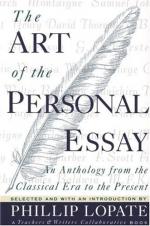
|
| Name: _________________________ | Period: ___________________ |
This quiz consists of 5 multiple choice and 5 short answer questions through Chapter 3, The Rise of the English Essay- Page 113-211.
Multiple Choice Questions
1. What does a woman's level of attachment to a man depend upon, according to Sei Shonagon?
(a) The way the man takes his leave of the woman.
(b) The way a man smells.
(c) The quality of gifts the man gives the woman.
(d) The elegance with which a man talks to the woman.
2. Who wrote "A Chapter on Ears?"
(a) Abraham Cowley.
(b) Plutarch.
(c) Maria Edgeworth.
(d) Charles Lamb.
3. What is Montaigne's general view of humanity?
(a) Humans are murderous animals.
(b) Humans are vain and shameful.
(c) Humans are courageous and bold.
(d) Humans are noble and wise.
4. Beyond the Monstrous Child, who else is discussed in "Of a Monstrous Child?"
(a) A man who claimed to see demons in his sleep.
(b) A man in his thirties with no genitalia.
(c) A man who grows too much hair like a wolf.
(d) A woman who sleeps with men and then steals their money.
5. From his second book on, what subject did Montaigne promise to pursue?
(a) Himself.
(b) His wife.
(c) Death.
(d) Nature.
Short Answer Questions
1. Why prompted Montaigne to retire from his career to pursue writing?
2. What is wrong with the child in "Of A Monstrous Child?"
3. Where did Maria Edgeworth get her nontraditional views from?
4. What does Montaigne admit in "Of Books?"
5. What did Kenko become in 1324?
|
This section contains 312 words (approx. 2 pages at 300 words per page) |

|




